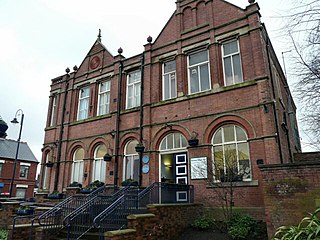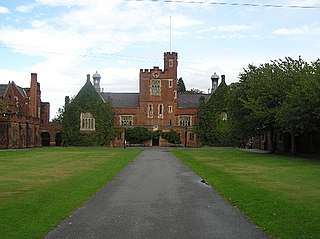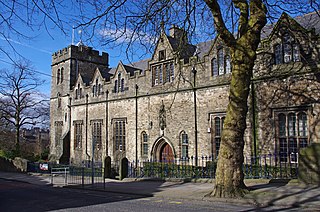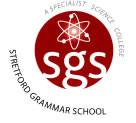
Tameside is a metropolitan borough of Greater Manchester, England, named after the River Tame, which flows through it, and includes the towns of Ashton-under-Lyne, Audenshaw, Denton, Droylsden, Dukinfield, Hyde, Mossley and Stalybridge. Tameside is bordered by the metropolitan boroughs of Stockport to the south, Oldham to the north and northeast, Manchester to the west, and to the east by the Borough of High Peak in Derbyshire. As of 2022, the population of Tameside was 232,753, making it the 8th-most populous borough of Greater Manchester by population.

Denton is a town in Tameside, Greater Manchester, England, five miles (8 km) east of Manchester city centre. Historically part of Lancashire, it had a population of 36,591 at the 2011 Census.

Ashton-under-Lyne is a market town in Tameside, Greater Manchester, England. The population was 48,604 at the 2021 census. Historically in Lancashire, it is on the north bank of the River Tame, in the foothills of the Pennines, 6 miles (9.7 km) east of Manchester.

Dukinfield is a town in Tameside, Greater Manchester, England, on the south bank of the River Tame opposite Ashton-under-Lyne, 6.3 miles (10.1 km) east of Manchester. At the 2011 Census, it had a population of 19,306.

Audenshaw is a town in Tameside, Greater Manchester, England, 4.9 miles (7.9 km) east of Manchester. Historically part of Lancashire, in 2011 it had a population of 11,419.

Droylsden is a town in Tameside, Greater Manchester, England, 4.1 miles (6.6 km) east of Manchester city centre and 2.2 miles (3.5 km) west of Ashton-under-Lyne, with a population at the 2011 Census of 22,689.

Loughborough Grammar School is a 10–18 private boys' school in the town of Loughborough, Leicestershire, England, founded in 1495 by Thomas Burton. Today, roughly one in ten boys at the school are boarders, with the remainder being day students. It is one of five schools known as the Loughborough Schools Foundation, along with Loughborough High School, Fairfield Preparatory School, Loughborough Amherst School and Loughborough Nursery.

The Royal Grammar School (RGS), Newcastle upon Tyne, is a selective British private day school for pupils aged between 7 and 18 years. Founded in 1525 by Thomas Horsley, the Mayor of Newcastle upon Tyne, it received royal foundation by Queen Elizabeth I and is the city's oldest institution of learning. It is one of seven schools in the United Kingdom to bear the name "Royal Grammar School", of which two others are part of the independent sector.
Frank Hampson was a British illustrator. He is best known as the creator and artist of Dan Dare and other characters in the boys' comic, the Eagle, to which he contributed from 1950 to 1961.
The Trinity School of John Whitgift, usually referred to as Trinity School, is a British private boys' day school with a co-educational Sixth Form, located in Shirley Park, Croydon. Part of the Whitgift Foundation, it was established in 1882 as Whitgift Middle School and was a direct grant grammar school from 1945 until 1968, when it left the scheme. The present name was adopted in 1954, to avoid confusion with Whitgift School. The school's head is now a member of the Headmasters' and Headmistresses' Conference (HMC).

Lancaster Royal Grammar School (LRGS) is an 11–18 boys grammar school in Lancaster, Lancashire, England. Old students belong to The Old Lancastrians. The school's sixth form opened to girls in 2019. LRGS is also in the United Kingdom's thirty oldest schools.
North Chadderton School is a mixed gender secondary school and sixth form, located in Chadderton, in the Metropolitan Borough of Oldham, Greater Manchester, England.

Eric Evans, was the captain of the England rugby union team from 1956 to 1958.

Sutton Grammar School is a selective state grammar school for boys aged 11–18 with a coeducational sixth form. Located in South London, the school's main site is in Sutton and its playing fields are in neighbouring Cheam.

Lymm High School is a secondary school and sixth form with academy status, located in Lymm, Warrington, Cheshire.

Sandbach School is an 11–18 boys free school in Sandbach, Cheshire, north-west England. It was established in 1677 by local philanthropists, including Richard Lea, who donated the land for the school, and Francis Welles, who helped to fund the schoolhouse. It was located at Egerton Lodge, Middlewich Road, before moving into a new set of buildings designed by George Gilbert Scott in 1851.
Crompton House CE School is a coeducational Church of England secondary school and sixth form located in the High Crompton area of Shaw and Crompton in the Metropolitan Borough of Oldham, Greater Manchester, England.

St Ambrose College is a Christian Brothers' Roman Catholic boys' grammar school in Hale Barns, Altrincham, Greater Manchester, England. It was founded in 1946 by Joseph Robertson. In 2012 the school became an academy, and was completely re-built. Upon leaving the college, boys are referred to as ‘Old Ambrosians’ and many go on to join the Old Boys' Association.

Wirral Grammar School for Boys is an 11–18 boys maintained selective grammar school founded in 1931. It is situated on a 9.1 acres (3.7 ha) site to the west of Port Sunlight at Cross Lane, Bebington, on the Wirral Peninsula in England. Academically successful, the school was placed 42nd in the top 100 in the Daily Telegraph A-Level table in 2015 and 145th in the DfE GCSE table in the same year, but has not been inspected since its conversion to academy status.

Stretford Grammar School is a grammar school located in Stretford, in the Trafford borough of Greater Manchester, England. It is located on a 15-acre plot in the heart of Stretford, Trafford.

















